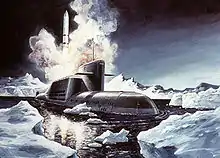R-29RM Shtil
The R-29RM Shtil[4] (Russian: Штиль, lit. "Calmness", NATO reporting name SS-N-23 Skiff) was a liquid propellant, submarine-launched ballistic missile in use by the Russian Navy. It had the alternate Russian designations RSM-54 and GRAU index 3M27.[5] It was designed to be launched from the Delta IV submarine, each of which is capable of carrying 16 missiles. The R-29RM could carry four 100 kiloton warheads and had a range of about 8,500 kilometres (5,300 mi).[6] They were replaced with the newer R-29RMU2 Sineva and later with the enhanced variant R-29RMU2.1 Layner.
| R-29RM Shtil/RSM-54 | |
|---|---|
 | |
| Type | SLBM |
| Service history | |
| In service | 1986–2010 |
| Used by | Soviet Navy Russian Navy |
| Production history | |
| Designer | Makeyev Rocket Design Bureau |
| Manufacturer | Krasnoyarsk Machine-Building Plant |
| Specifications | |
| Mass | 40.3 tonnes[1] |
| Length | 14.8 metres[1] |
| Diameter | 1.9 m[1] |
| Warhead | The payload (2800 kg) was capable of carrying ten 100 kT yield MIRV warheads, though only a four MIRV warhead version entered production. |
| Blast yield | 200 kt each [2] |
| Engine | Three-stage liquid fueled stages using N2O4/UDMH propellant[3] |
Operational range | 8,300 kilometres (5,200 mi)[1] |
Guidance system | Astroinertial[1] |
| Accuracy | CEP 500 metres[1] |
History
Development
Development of the R-29RM started in 1979 at the Makeyev Rocket Design Bureau. The navy accepted the armament in 1986 and subsequently installed the D-9RM launch system consisting of a cluster of 16 R-29RM onboard the nuclear-propelled Project 667BDRM submarines.[3]
Operation Behemoth
On 6 August 1991 at 21:09, K-407 Novomoskovsk, under the command of Captain Second Rank Sergey Yegorov, became the world's only submarine to successfully launch an all-missile salvo, launching 16 R-29RM (RSM-54) ballistic missiles of the total weight of almost 700 tons in 244 seconds (operation code name "Behemoth-2"). All the missile hit their designated targets at the Kura Missile Test Range in Kamchatka.[7]
Space Launch Vehicle
Several R-29RM were retrofitted as Shtill carrier rockets to be launched by Delta-class submarines, the submarines being mobile can send a payload directly into a heliosynchronic orbit, notably used by imaging satellites. Outside the confines of the Russian military, this capability has been used commercially to place three out of four microsatellites into a low Earth orbit with one cancellation assigned to the Baikonur Cosmodrome for better financial terms.
End of service
The last boat carrying R-29RM, K-51 Verkhoturye, went into refit to be rearmed with the newer R-29RMU Sineva on 23 August 2010.[8]
Operators
See also
References
- "R-29RM / SS-N-23 SKIF". nuke.fas.org. Retrieved 1 August 2022.
- "ВОЕННАЯ ЛИТЕРАТУРА --[ Техника и вооружение ]-- Стратегическое ядерное вооружение России". militera.lib.ru.
- "R-29RM / SS-N-23 SKIFF". globalsecurity.org. Retrieved 1 August 2022.
- "Aviation.ru – Missiles". Archived from the original on 4 November 2008.
- "R-29RM Shetal/Sineva (SS-N-23 'Skiff'/RSM-54/3M27) (Russian Federation), Offensive weapons". Janes.com.
- "R-29RM Shtil (SS-N-23)". Missile Threat.
- "Submarine-launched ballistic missiles". russianspaceweb.com. Retrieved 25 August 2019.
- "SSBN K-51 Verkhoturye arrived to Zvezdochka for repairs today". Rusnavy.com. 23 August 2010.